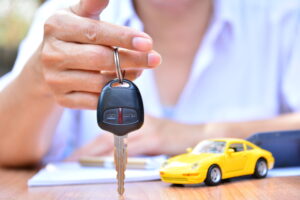Just because someone has a license, it doesn’t mean they’re ready to drive.
As a personal injury attorney, I have seen my fair share of terrible car accidents. As the father of twin boys who got their Virginia driver’s licenses, I couldn’t help but be worried every time they got behind the wheel of a car. They had both taken the driver’s education classes in school, had gone through “behind the wheel” training, and completed the required amounts of driving during the day. But nighttime driving, highways, and back roads were just the tip of the iceberg regarding the practice they needed. Continued education and experience are imperative.

Car accident statistics for teenage drivers
According to the latest data compiled by the National Highway Traffic Safety Administration (NHTSA), these are statistics for young drivers (between 15-20 years old):
- In 2021 2,116 young drivers died in traffic crashes, an 11% increase from 1,899 in 2020.
- In 2021 there were an estimated 203,256 young drivers injured in traffic crashes, an increase of 7% from 189,959 in 2020.
- Young drivers accounted for 8.4 percent of all drivers involved in fatal traffic crashes in 2021, though young drivers accounted for only 5.0 percent of all licensed drivers in 2021.
- Most teen driver crashes are due to three “critical errors:” lack of scanning, speeding, and distractions.
- Teenage driving statistics also show that teens are more likely to crash if impaired, using a cell phone, or with peer passengers.
Motorcycle statistics for young drivers
If you think it is stressful having a teenager behind the wheel of a car, imagine if they rode a motorcycle. This is the case for many families across the U.S., and the statistics for those who don’t wear helmets are chilling.
- Twenty-one percent of the motorcycle riders 15 to 20 years old who were killed in traffic crashes were not wearing helmets.
- In 2021 there were 277 young motorcycle riders killed in traffic crashes, an increase of 41% from 197 young motorcycle riders killed in 2020.
- An additional estimated 4,818 young riders were injured in 2021.
- NHTSA estimates that helmets saved the lives of 1,872 motorcyclists of all ages in 2017 (latest data available), and that if all motorcyclists had worn helmets, an additional 749 lives
could have been saved.

As parents, we must continue to do everything in our power to impress upon teen drivers that they are now participating in something that could have grave effects on the rest of their lives. Your teen still believes they are “bulletproof” and it can be difficult for them to comprehend that their decisions on the road could bring about bad consequences. So, what can we do?
1. Lead by example
We need to drive in such a way that our teens can “model” our behavior. That means to make sure we:
- Watch our speed.
- Wear our seat belts.
- Do not text or use our phones in an unsafe manner.
- Keep safe following distances.
- Obey traffic laws.
- Don’t drink and drive.
- Don’t get overly upset due to other drivers or traffic conditions.
This may be the hardest thing for us parents to do because we are set in our ways – right or wrong. But we must understand that we are teaching kids that our behavior is acceptable – when we know it really isn’t.
2. Continue to educate
Every time you ride or drive with your teen, talk about what they are doing and why they are doing it. Inquire into many areas of the trip. Examples of questions include:
- Which lane is the best for their purpose?
- What are they looking for up the road that could be a potential hazard?
- What kinds of things have they noticed other drivers doing that have been dangerous?
- Based on the current weather, should they be altering their driving behavior? If so, in what way?
I have found that if you can talk about anticipating things “coming up” as they travel, then teenage drivers are more prepared when they occur. This positive method of teaching is more effective than waiting until your teenage driver doesn’t react as you think they should. It’s difficult to direct or teach in the middle of the chaos. Often the urgency of the situation may cause you to raise your voice in a way that’s likely to fluster and distract your teen, instead of being the helpful learning experience that you were aiming for.
3. Set expectations before your teenager starts to drive
Decide on what your “ground rules” are, and discuss them in advance. Explain to your teenager that these rules must be followed if they plan on using your car. Helpful examples of ground rules include:
- They must let you know where they are going.
- Call you upon arrival and departure from any location
- Confirm passengers (if any – it is recommended they have as few as possible)
- No using a phone for any reason while driving.
- If you must use a phone, then you must pull off of the road.
- Follow the traffic and speed limit signs.
- Absolutely no alcohol use
- Keep distractions from passengers and/or music at a minimum.
- No aggressive or thrill-seeking behavior when behind the wheel.
Many of these rules aren’t just rooted in common sense, they are rooted in the law. The Virginia DMV has a specific set of restrictions for teen drivers. One of which states, “If you are under age 18, you may carry only one passenger under age 18 during the first year that you hold your driver’s license. After you have held your license for one year, you may carry only three passengers under age 18 until you reach age 18. Learner’s permit holders may not carry more than one passenger under age 18. Passenger restrictions do not apply to family members. Violations of either the curfew or passenger restrictions can result in the suspension of your driver’s license.”

4. Take advantage of resources
AAA has a website that provides useful information for all new drivers and their parents. It includes a Parent-Teen Driving Agreement. Your child must read, understand, and sign before they drive. Proving that they’re responsible can mean more privileges. And if rules are violated, that should equal consequences. Driving for most teens is a luxury and not a necessity, so if they cannot follow your rules, then this privilege must be taken away.
Parents must continue to be involved for the sake of the teen and the public. We must do all we can to keep both safe. In driving as in everything else, actions have consequences. And while driving, the consequences can be catastrophic and life-changing.
If you or a loved one have been injured in an accident through no fault of their own, they may be entitled to compensation. Call the compassionate car accident attorneys at Allen & Allen for a free case evaluation, at 866-388-1307. We’re here to help.



